Tibet's sacred arts, from monastery architecture and thangka paintings to traditional opera and music. These arts are all part of Tibetan spiritual path.
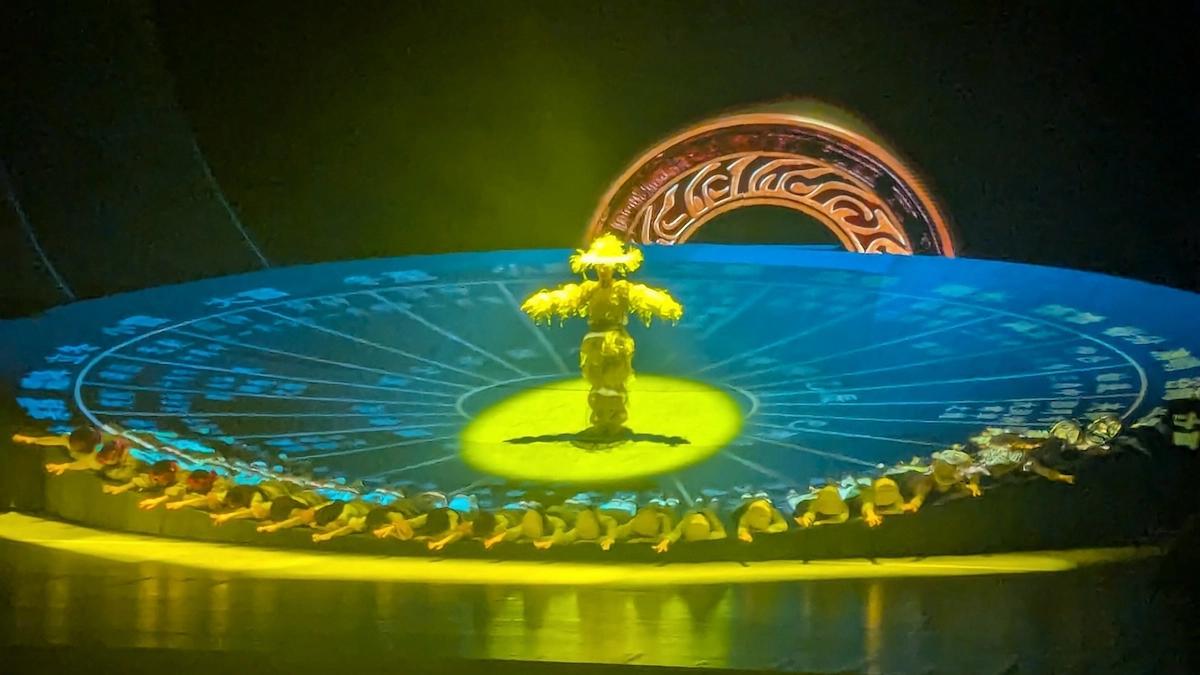
The Tibetan people are often seen as carrying an air of mystery. Their wisdom, understanding of life, compassion, tolerance, and inner peace all shape the culture of Tibet.
The simplicity of life, the spirituality of minds, and rich customs and traditions give this region its strength and character.
Tibetan art and architecture, deeply rooted in spirituality, have been predominantly religious in nature. The Tibetan perspective on art is that a completed piece possesses its own existence and an inherent power to guide the viewer towards spiritual enlightenment. The art of Tibetan Lamaism, influenced by Hinduism and Buddhism, and later by Chinese art, is a testament to the spiritual depth of Tibetan culture.
Artists in Tibet have often been monks or devout laypeople; the act of creation by itself was often a form of meditation or spiritual practice. The artists' names were frequently left off the frame as the focus was on the act, not the individual.
In architecture, the chorten, or Tibetan stupa, was derived from Indian prototypes and was composed of one or more square bases, a square balcony, a bulbous dome, and a mast upholding umbrellas, surmounted by a flame finial.
Tibet is famed for its gigantic monastery-cities, which house thousands of monks. The one at Tashi Lumpo, built in the 15th century, is the headquarters for the Tashi Lama.
A labyrinthine complex, it is composed of long streets of cells, which surround courtyards. At the center is a shrine. The 17th-century monastery at Lhasa includes the Potala palace, residence of the Dalai Lama, and a series of monastic skyscrapers that echo the forms of the surrounding mountain peaks.
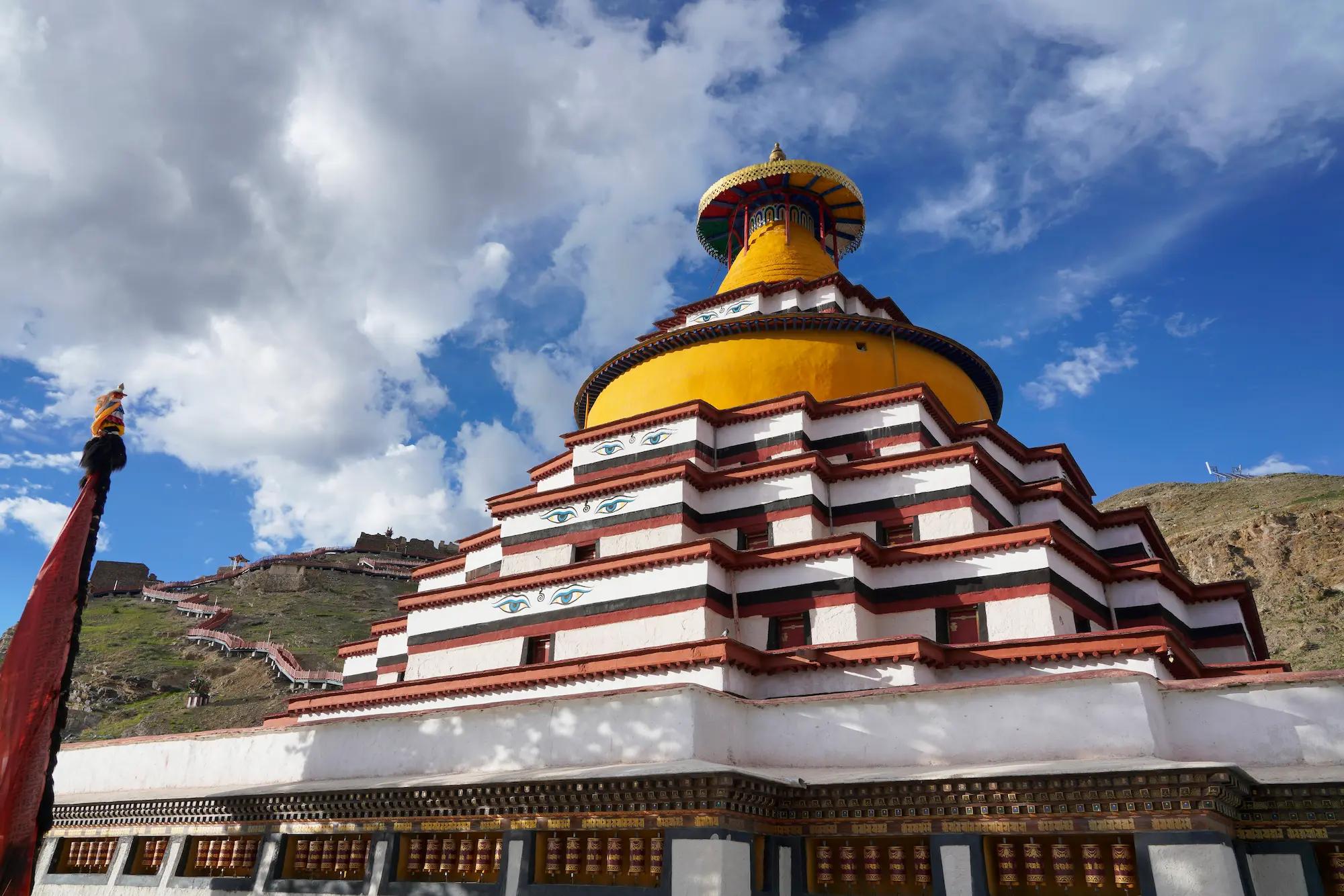
Gyantse famous stupa
Tibetan sculpture, often in the form of gilt bronze statuettes, consists of slim, elegant figures with heart-shaped heads, resembling the Indian Pala or Nepalese figures and frequently ornamented with elaborate jewels.
Metal, clay, stucco, wood, stone, and butter are all used in the creation of sculptural images, yet by far the best known of these is metal, since small, portable, bronze images of a great variety of meditation deities are most frequently encountered.
Nevertheless, clay and stucco have been used since ancient times, particularly in the creation of very large images installed in monasteries and temples.
Wood is also widely used, intricately carved for entrances to temples and for interior pillars, and in covers for scriptures in monastery libraries.
Works of art are usually commissioned, either by monasteries or lay patrons, and their execution generally follows strict canonical rules as to proportions, symbols, and colors, in accordance with artistic manuals.
Butter sculptures are intricate, multi-colored sculptures made from yak butter and pigments, created for religious festivals like the Monlam Great Prayer Festival. They are temporary, melting artworks, again highlighting the theme of impermanence.
The Significance of Sculptural Deities
The great variety of meditation deities aren't gods to be worshipped in a Western sense, but instead represent different aspects of the enlightened mind (e.g., compassion, wisdom, power) used as focal points in meditation.
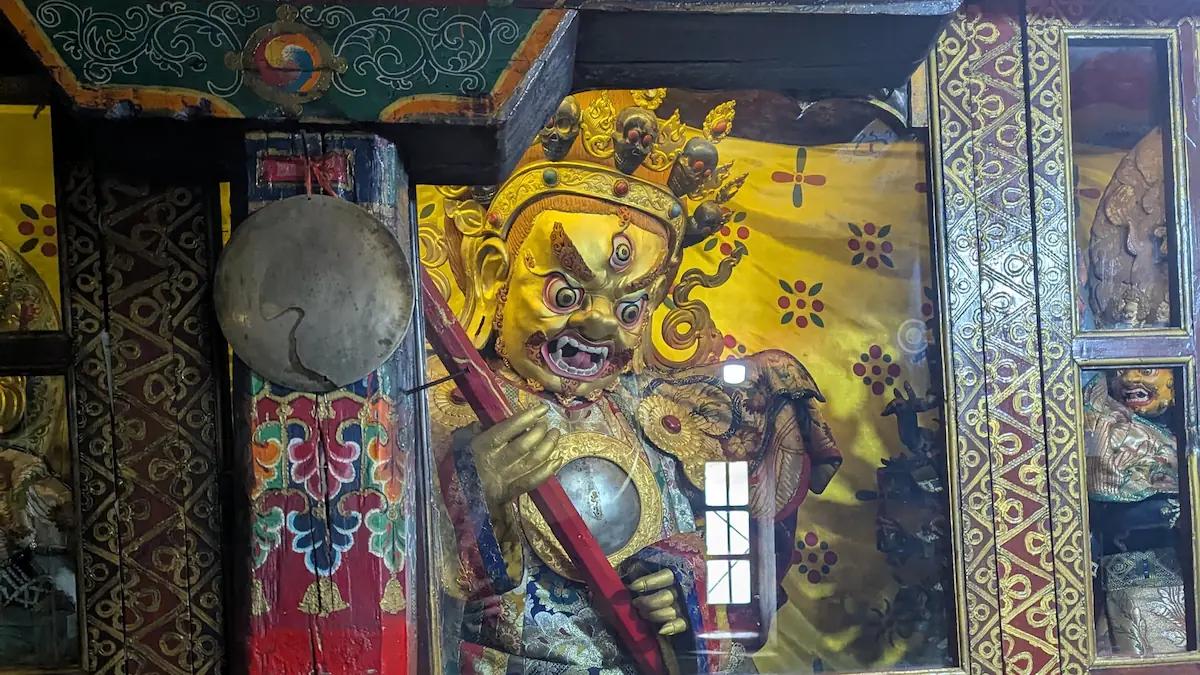
Tibetan paintings that appear most frequently are the Thangka or scroll painting, usually painted with brilliant colors on cotton cloth, more rarely on silk.
Thangkas are traditionally mounted in frames of silk brocade with a pole or batten at the top and bottom so that it can be easily hung. Since it is also easily rolled up, the Thangka can be stored away or readily transported from one place to another.
Itinerant lamas used them as icons of personal devotion and to sanctify tents in which they held teachings of Buddhist doctrine. They are also used as effective teaching aids.
In most Tibetan homes, the Thangka, together with small bronze images, is an integral part of the family altar and a vehicle of visual dharma.
The central figures of Thangkas may follow Nepalese or Indian types, but their decorative details, such as cloud scrolls, flowers, and architectural motifs, are often of Chinese origin. It is difficult to date these paintings, since the text, canons of proportion, and technical rules for making them have been almost unvaried for centuries.
The symbolism is highly complex. Strongly schematized paintings portray ritual diagrams, scenes of the pantheon of divinities, and the wheel of life.
Manuscripts are often adorned with miniature paintings, as are their wooden covers, and sets of initiation cards, called tsakali, which are another medium of miniature painting.
The technique of Thangkas
Colors are traditionally made from minerals as well as vegetable dyes. Before application, they are de-saturated in varying degrees in lime and mixed with boiled gum Arabic.
These colors maintain their intensity so well that many old Thangkas still retain striking colors. Today, Tibetan artists also use modern synthetic dyes.
Artists first must prepare the canvas by stretching it and applying a ground of gesso (chalk and glue). The initial sketch is drawn using a grid based on strict guidelines to ensure spiritual accuracy. Only then is color applied.
With the profound Tibetan Buddhism influence, Tibetan music is of a religious nature first. The ethnic music melodies also incorporate music features from India, Bhutan, Nepal, and beyond. Enriched for centuries, Tibetan music has developed a unique character, incorporating various ethnic tastes. In some way, the music of Tibet is a reflection of the cultural heritage of the trans-Himalayan region, while also showcasing Tibetan culture.
A powerful symbol of Tibetan art lies in its dances and songs; there, people embody artistic expression within their souls. Every performer is both a singer and a dancer.
The singing style of Tibetans is quite peculiar, and their songs are sung from the throat in a way that makes the sound echo in the valley and can be heard even from long distances. The people of Tibet consider it one of the means of spreading their beliefs and religion as far as possible.
What are some Tibetan traditional instruments?
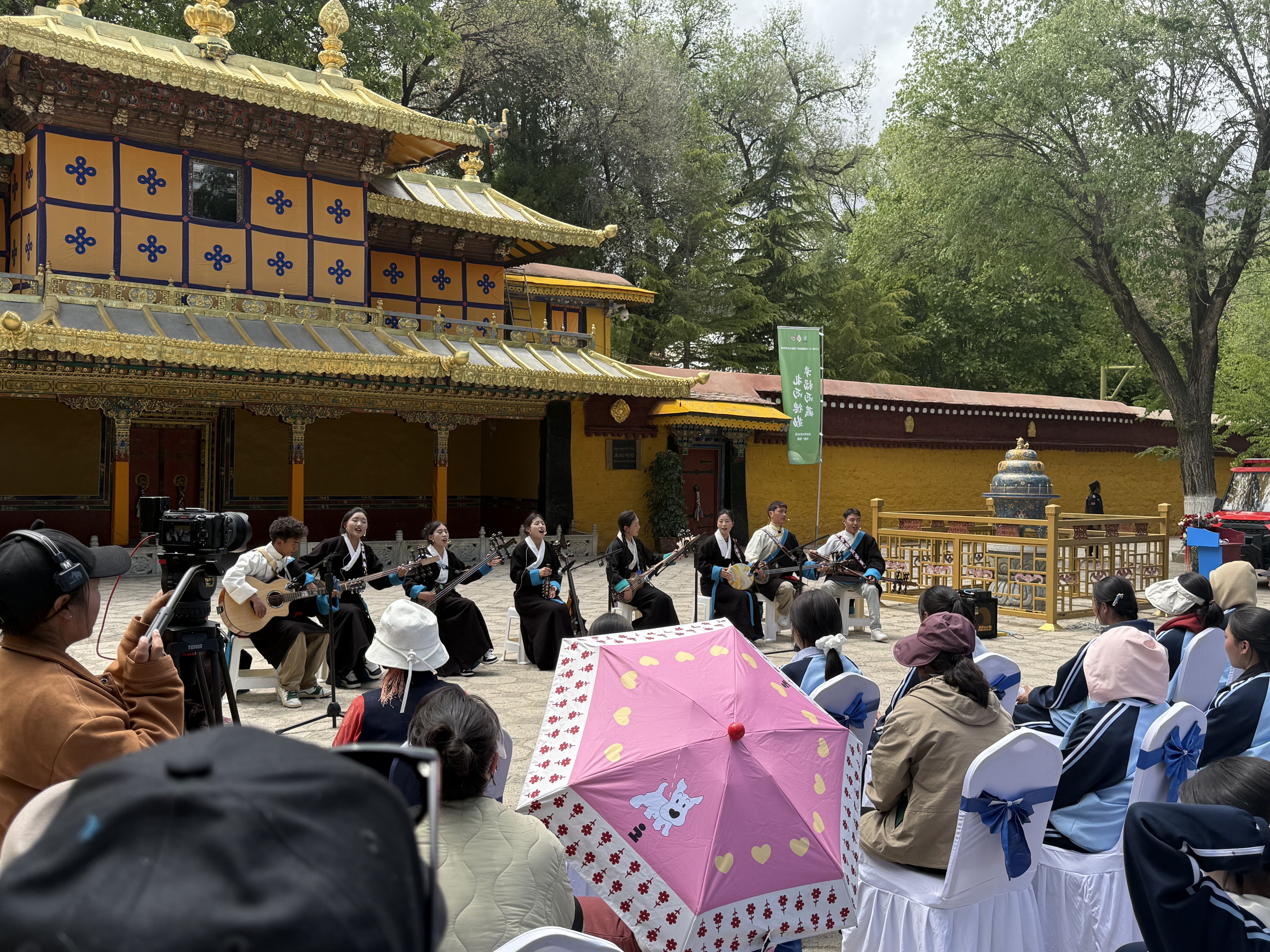
Concert at the Norbulingka summer-palace
Dances definitely have an entertainment edge to them as well. They are generally performed during various festivals or celebrations. Dances like Guoxie, Duixie (Tibetan Tap dance), and Quamo dance are an important part of cultural events in Tibet.
Lhasa Langmar is a traditional musical dance for Tibetans originating from Lhasa. The name Langmar refers to the Langmar Mound of the Potala Palace, where it was first performed. Its performance style combines singing and dancing.
Over time, Langmar spread throughout Tibet, incorporating dance movements similar to the Duisher rhythm. Langmar combines both song and dance. Today, Langmar remains deeply rooted in folk tradition, and visitors can still experience Langmar performances at festivals across Tibet.
This is an important religious dance performed by monks during festivals. Dancers wear elaborate masks and costumes representing deities, protectors (Dharmapalas), or skeletons. Its purpose is to destroy evil forces and bestow blessings upon viewers.
Tibetan opera, known as "Lhamo", is an ancient cultural tradition with mysterious origins.
This art form is reputed as "the living fossil of traditional Tibetan culture," with a history of more than 600 years (400 years longer than the very traditional Beijing Opera)
A beautiful legend surrounds the birth of Tibetan opera. To raise funds for building iron bridges across Tibet's major rivers, a bridge builder named Drupthok Thangthong Gyalpo assembled a troupe of seven beautiful performers to sing and dance throughout Tibet. This touring group is believed to be the origin of modern Tibetan opera.
Originally called "Ace Lhamo," meaning "fairy sister" in the Tibetan dialect, this art form immortalized Thangthong Gyalpo as the father of Tibetan opera.
Tibetan opera follows a distinctive three-part performance structure:
The Prelude introduces the cast and provides exposition, explaining the storyline that will unfold in the main performance.
The Main Opera presents the dramatic narrative itself, featuring elaborate costumes, masks, and traditional music.
The Epilogue concludes with a blessing ceremony, during which audience members traditionally present hada (ceremonial silk scarves) and make donations to the performers.
This ancient art form continues to thrive as both entertainment and spiritual practice.
The use of masks is central to Tibetan opera, serving as a visual language that instantly communicates character types to the audience.
Each color carries a specific symbolic meaning:
red masks represent kings and rulers, green signifies queens and noble women, yellow is reserved for deities and high lamas, white indicates virtuous and pure-hearted characters, while the striking half-white, half-black masks mark sinister or duplicitous characters.
This color-coded system allows audiences to understand the moral and social standing of each character immediately.
Tibetan opera draws its rich narratives from Buddhist legends, Tibetan history, and ancient myths, weaving together spiritual teachings with dramatic storytelling.
The most celebrated works belong to the "Eight Great Operas," a collection of classic tales that form the main repertoire.
Among these, "Princess Wencheng" tells the story of a Chinese princess who married the Tibetan king Songtsen Gampo, symbolizing the cultural exchange between Tibet and China.
"Drimey Kunden" presents a powerful tale of supreme generosity and self-sacrifice, exploring Buddhist themes of compassion and spiritual merit.
These arts are not merely decorative but are a living, breathing system of knowledge, history, and spiritual practice that continues to define Tibetan identity.
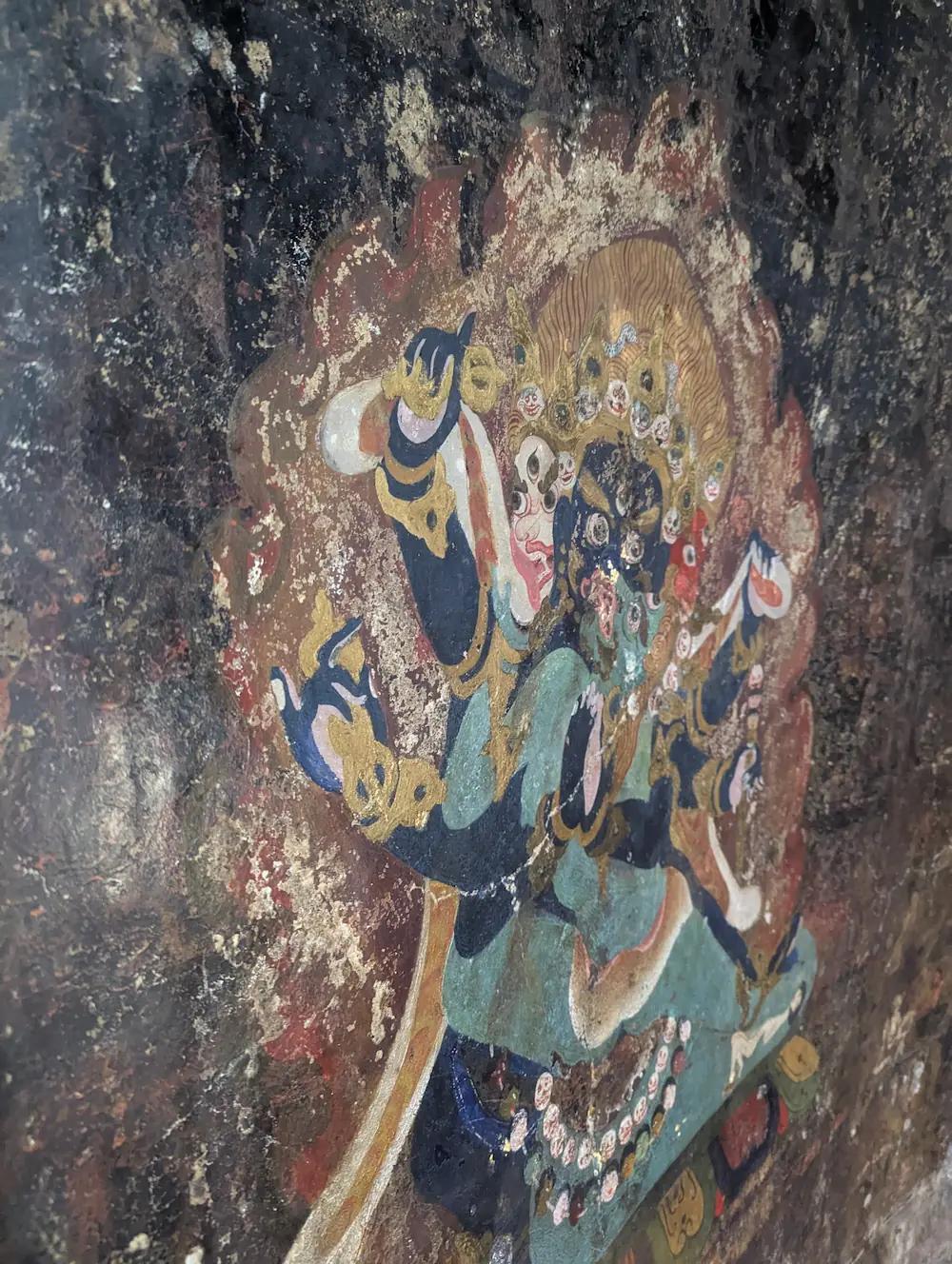
Tibetan God painting in a Temple